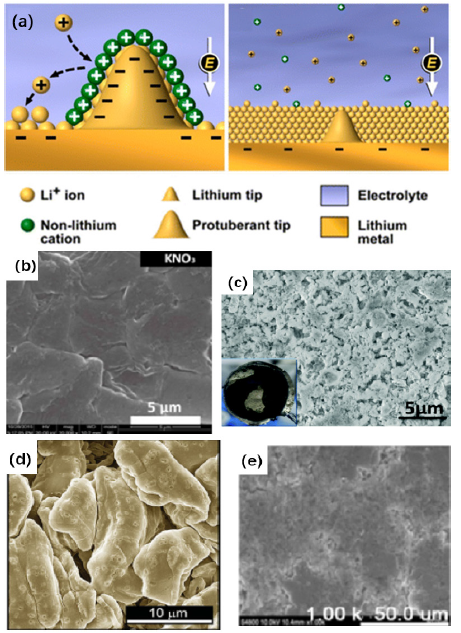Inhibiting Lithium Dendrites in Lithium Metal Batteries by Yuping Wu* in Aspects in Mining & Mineral Science_ Aspects in Mining & Mineral Science

Abstract
Characterized by high theoretical specific
capacity (3860mAh/g) and the lowest reduction potential (-3.04 V), the lithium
metal anode has received much attention in the continuous pursuit of
highperformance batteries. However, the problems of uncontrollable lithium
dendrite growth and the high chemical reactivity of lithium, which result in
low coulombic efficiency and short cycle life of lithium metal batteries, have
remained unsolved for decades. Even worse, the presence of lithium dendrites
poses serious risks to battery safety. In recent years, much work has been
conducted on the issue of lithium dendrites. In this review, we summarize the
latest basic strategies for solving the lithium dendrite problem, including the
choice of liquid electrolytes, the application of solid/gel electrolytes,
modification on separator, and tailored surface and scaffold for lithium metal
anode. In addition, challenges and prospects of lithium metal anodes are
discussed.
Keywords:
lithium dendrites; Graphite; Batteries; Materials
Introduction
As an important part of portable electronics and
new energy vehicles, batteries
have become an important factor restricting their rapid development. Of various
available rechargeable batteries, lithium-ion batteries have been
commercialized for large-scale applications due to their high specific
capacity, long cycle life and good safety performance [1]. After continuous
improvement, the current specific energy density of commercial lithium-ion batteries is
approaching its theoretical value but still cannot meet the growing needs for
higher energy densities. Normally, graphite is employed as an active
intercalation anode material; during the charge process, the Li+ ions
intercalate into the graphite, while the opposite occurs during the discharge
process. Due to the limited space between graphite layers, its theoretical
specific capacity is restricted to 372mAh/g [2]. As a result, an anode system
with a higher energy density has to be found urgently. Studies on lithium metal
anodes started in the 1970s. When lithium metal is used as the anode, its
mechanism is based on deposition or stripping of Li+ ions, with its theoretical
specific capacity reaching 3860mAh/g. Furthermore, because it has the lowest
known reduction potential (-3.04 V vs S.H.E.) and low density (0.59g/cm3) [3],
the theoretical specific capacity of the battery can be increased greatly, so
that lithium metal is one of the most promising anode materials. However, the
formation of lithium dendrites has been a major problem for lithium metal
anodes for a long time. Suffering from the uncontrollable growth of lithium
dendrites on the lithium metal anode, lithium metal batteries exhibit low
coulombic efficiency and short cycle life. Even worse, lithium dendrites give
rise to safety hazards because they cause short-circuits.
https://crimsonpublishers.com/amms/fulltext/AMMS.000596.php
For
more Open access journals in Crimson Publishers,
Please
click on the link: https://crimsonpublishers.com/
For
more articles in Aspects in
Mining & Mineral Science,
Please
click on below link: https://crimsonpublishers.com/amms/
Follow
On Publons: https://publons.com/publisher/6342/crimson-publishers/
Follow
On Linkedin: https://www.linkedin.com/company/crimsonpublishers/
High
impact journals in Crimson Publishers?
https://www.quora.com/What-are-the-high-impact-journals-in-Crimson-Publishers
Crimson
Publishers Journals
https://crimsonpublishers.com/



No comments:
Post a Comment